
by Scott K. Johnson Monday, June 23, 2014

You never know what you're going to find at the fair. Credit: ©iStockphoto.com/Lokibaho.
County fairs are opportunities to bring in those handsome Holsteins competing for Best Bessie, to sample foods that don’t normally belong on sticks and definitely shouldn’t be deep-fried, and to enjoy carnival rides and games with unfavorable odds. They’re also opportunities to get the attention of a lot of people. Just ask the exhibitors who pay for space to hawk their wares.
A stroll down the aisles might reward you with demonstrations of satellite television, discount kitchen knives, a rainbow display of bathroom tiles, leaf-proof gutters, or made-to-order portraits of your pets. And here and there, tucked among the commercial commotion, there might be an organization that just wants to get its message out. Some host simple tables seeking donations for causes or interest in community groups. Others are flashier. For example, you might come across a booth sporting a 2-meter-long banner that asks, “Why do thousands of scientists believe Darwin was wrong?”
You’ll find that last one at the Dane County Fair in Wisconsin’s capital city of Madison. But I would wager that you could find something similar at fairs or other venues elsewhere in the U.S. The favored method of vocal creationists supporting their cause has long been to cast doubt on the sciences of geology and evolutionary biology. Countering that message with the scientific method — and the evidence it has produced — is one goal of science outreach efforts, but success doesn’t come easy.
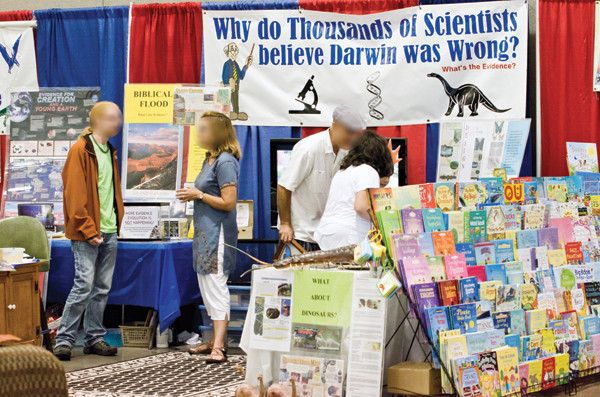
The "What's the Evidence?" booth (as seen in 2012) has been at the Dane County Fair for several years. Credit: Ingrid Laas.
In 2012, while teaching at Madison College, I became aware of the county fair creationist push. For several years, a booth put up by a group of people calling themselves, or at least their booth, “What’s the Evidence?” has been making appearances at several Wisconsin county fairs, pitching the ideas and literature of the “creation science” movement.
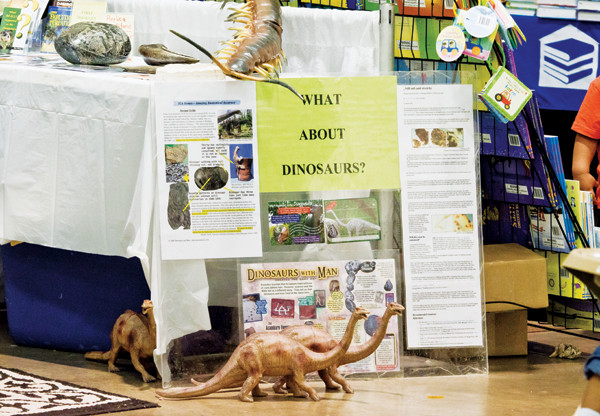
According to the display, dinosaurs and people coexisted. Credit: Ingrid Laas.
If their flashy banner isn’t enough to pull you in, their friendly, smiling greetings might seal the deal. The nearly 2-meter-long replica dinosaur femur certainly won’t hurt. A few smaller fossils surround it as part of a display proclaiming the fossil record as proof that evolution never occurred. (And yes, they say, people coexisted with dinosaurs.) After all, some fossils look like organisms that are still alive today. And their penny press machine — creating a flattened penny with an image of a trilobite surrounded by the text, “Fossils formed in the Biblical flood; Genesis 6-9” — is sure to draw in the kids.
This group recasts the geologic record as the ruins of Noah’s Flood. The fact that the processes that would produce the rock record in evidence today would take great spans of time at modern rates (the uniformitarian description) is simply seen as a testament to the awesome scale of that catastrophic event.
To further draw in spectators, there’s also a vibrant butterfly poster testifying to the role of intelligent design and a looped video evangelizing with Christian messages from scripture.
After a couple of years of being chaffed by this unchallenged creationism at the fair, Nick Schweitzer — a retired attorney and Madison-area science booster who had previously paid to erect planetary sign posts illustrating the scale of the solar system along Madison’s main commuter bike path — decided to do something about it. He wanted to give science a greater presence at the fair, so he rented space for a booth on the opposite side of the exhibit hall. (The booth was meant to be constructive rather than confrontational, Schweitzer says, so he made a point of setting up far from the creationists’ space.) Then Schweitzer set about finding people at the University of Wisconsin who could supply some interesting material to present.
I connected with Schweitzer through the geology museum at the university, where I had recently completed a master’s degree in hydrogeology. We put together a wide-ranging, if slightly eclectic, exhibit. Armed with giant astronomy photos, fossil replicas, biology posters, a website cleverly (we thought) titled wonderWI.com, and a couple of activities for kids, we arrived at the fair in 2012 with absolutely no idea what to expect. A crush of crowds? Active shunning? Arguments? Silence?
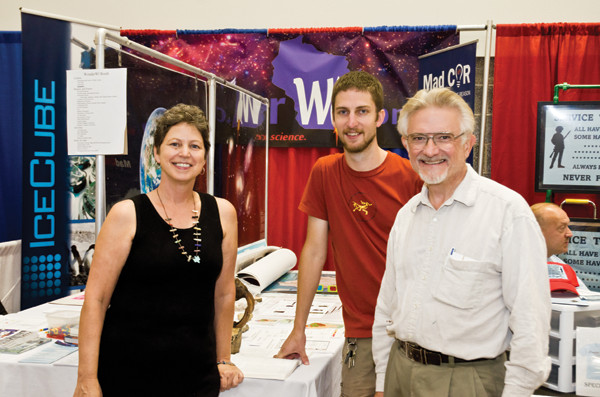
With the patronage of Nick Schweitzer (right, in middle image), a retired attorney and Madison-area science booster, the author (center) helped put together a booth with a variety of scientific displays. Credit: Ingrid Laas.
Interest from fairgoers turned out to be tepid. (Proximity to a petting zoo with fuzzy ducklings may not have helped.) Occasionally, the mastodon and woolly mammoth teeth would catch someone’s eye, and we’d strike up a conversation about Wisconsin’s Pleistocene megafauna. A surprising number of people were unable to resist the allure of red and blue glasses hanging next to a 3-D topographic map of the state. But all too often, we twiddl"d our thumbs an" gazed across the hall to see the impressive crowds being pulled in by the creationist booth.
It wasn’t long before the creationists sent scouting parties our way. They would casually paw through our display with the polite disinterest of someone killing time in a knick-knack shop. Then they would try to stump us. Did we know how slowly the moon drifted away from the Earth? Surely the sign of a stable, guiding, omnipotent hand, they said. With so many dubious assumptions involved, how could we be sure that carbon dating (always “carbon,” never “radiometric”) was accurate if we weren’t there to experience ancient events for ourselves? Why is it that scientists have never found a single transitional fossil between species? And isn’t the human eye just too marvelous to have come into existence through some random process?
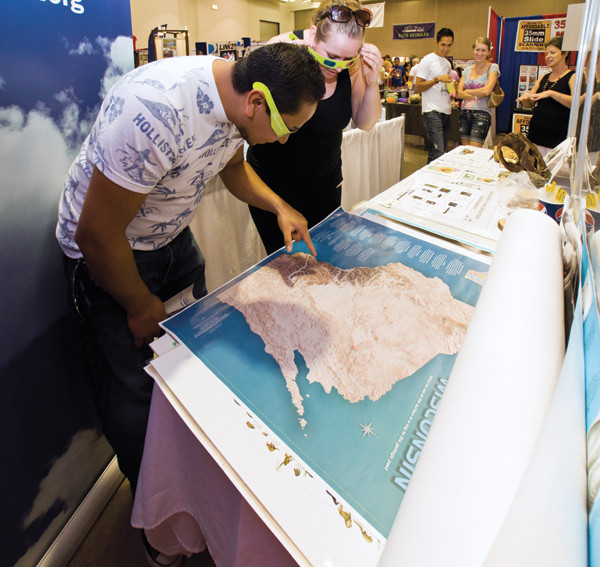
The science booth generated some interest and great interactions with those people who stopped by. The 3-D map of Wisconsin was an especially big hit. Credit: Ingrid Laas.
Eventually, each exchange would end with a smile and an invitation to visit their booth. When I acquiesced to the hospitality of one of our interlocutors, I was handed glossy “textbooks” that sought to set me straight on geology and the fossil record. We had a long conversation about the Grand Canyon, which is seen as a particularly illustrative remnant of the Biblical Flood — the layers were deposited during the chaos of the Flood, and the canyon was carved into the soft sediment as the Flood waters retreated. So-called “Flood geology” thrives on oversimplification. I asked why there were so many different layers of varying sediment types representing high- and low-energy environments, some with trace fossils showing that organisms lived out their whole lives within certain intervals. But my question was waved away as a minor detail: There must have been a series of varying currents during the Flood that would surely explain it, I was told.
Curiously, they held that ductile deformation of solid rock is impossible, making folds in Grand Canyon rocks proof that deformation took place within a compressed, post-Flood timeline while the sediment was still unlithified. When I pointed out that ductile deformation of rock in laboratory experiments was a regular and unremarkable occurrence, my host admitted that he had never heard of such a thing.
Soon, all pretense of a scientific debate was abandoned. Instead, he wanted to know about my relationship with Jesus. These folks were nothing if not sincere and genuine, but they weren’t there because of a passion for the scientific method. I understood their aims and motivation — I was raised on the same ideas — but it’s frustrating and difficult to debate geology with someone who has no intention of ever studying an outcrop, much less accepting the science.
Not everyone who visited the creationist booth agreed with its contents, but many people were at least interested enough to peruse. Their booth was spacious and inviting, and it made no bones about its controversial nature. Our booth, on the other hand, was a little too cramped, cluttered and nondescript. We had intended the smorgasbord of science to be a virtue, but it left passersby without a clear idea of what we were up to. If you can’t grab someone’s attention from a casual glance, you can’t get any attention at all.
That’s not to say success was completely elusive. Many children stopped to gawk at the fossils and were entertained enough to stay and build their own DNA bead bracelet or package a garden seed in a test tube so they could watch it sprout at home. And if you keep kids busy, you might just gain the attention of their parents as well. In a refreshing display of open-mindedness, the mother of one voraciously inquisitive child pointed to a poster on human evolution and asked, “So, is it really true that humans evolved from things like that?” Assured that this was what scientists have worked out, she simply replied, “Wow! Interesting…”
Another fellow started a conversation about how parts of Wisconsin’s landscape had been shaped by glaciers, which eventually led to talk of climate change. He wanted to know if the global warming of recent decades could be explained by solar activity — a claim he’d recently heard. When directed to sources of information showing that this was not the case, he seemed pleased with the answer. Perhaps these people just wanted to hear it from a real person who seemed knowledgeable. Then again, you have to wonder how many fairgoers similarly accepted creationist claims on the other side of the room for the same reason.
Despite the positive encounters, we knew we could do a better job of garnering interest. In 2013, Schweitzer rented a larger space so we could spread out. The fossils and the 3-D topographical map were prominently displayed and some of the less popular materials were retired. We also designed a few brightly colored posters with simple descriptions of Wisconsin’s geologic history and the age of Earth. The updated display was a definite improvement, but the response was similar to the previous year: some great interactions, but lower overall interest than the intelligently designed creationist display.
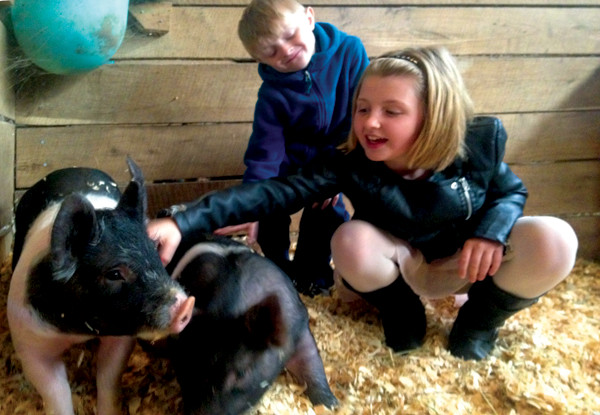
Scientists — and anyone — exhibiting at a fair have to compete with the likes of adorable animals and other attractions. The key is to grab kids' attention, and then you might just get the attention of the parents too. Credit: Laurin Olson Bartlett.
It’s hard to know how widespread of an effort creationists are making at public events like county fairs,“but they’re definitely working hard to spread their views, says Steven Newton of the National"Center for Science Education, an organization that works to defend the"teaching of evolution and climate change. Newton hasn’t heard about many efforts at county fairs — more often, he says, such groups target educators. For example, they have attended educational conferences, such as the annual National Education Association conference, where creationists hope to convince teachers to pass their message on to their students. These groups even show up at geology conferences, Newton notes, giving presentations and even leading field trips (a topic EARTH covered in July 2011).
More direct public outreach efforts have occasionally gained attention. Several years ago, prominent creationist Ray Comfort organized the distribution of copies of Darwin’s “On the Origin of Species,” printed with a creationist foreword, on many college campuses. Comfort found volunteers to buy the books and hand them out on their own time — an intense level of support, Newton says.
Such efforts are a perfect example of the challenge facing science advocates and educators, Newton says: “It’s hard to motivate people to defend what they assume is the default state, the status quo.” The creationist movement, he says, “sees itself as Luke Skywalker-type superheroes fighting the Empire.” It’s “easier then to motivate people to donate; both Answers in Genesis and the Discovery Institute, for example. A lot more could be done with outreach in support of science — if only there were the money to do it.”
If there is one thing we can learn from creationists at a county fair, it’s that outreach opportunities exist anywhere there is a crowd. Events like science festivals or Darwin Day — an annual celebration of science on Feb. 12, Darwin’s birthday — are important, but they often reach people who are already interested in learning about science or evolutionary biology. Science outreach activities that piggyback on nonscience events, however, can help scientists reach people they might not interact with otherwise.
But effective outreach isn’t easy in that kind of setting, as we found during our exhibit experiences. In order for you to have a conversation with someone or show them something interesting, they have to decide to engage with you. You need a hook at least as alluring as your competition.
If you do manage to win a captive audience, however, a simple conversation can sometimes make a difference. Inspiring a little curiosity is about as rewarding as baking a blue-ribbon pie — especially when you know someone else wanted to convince the judges that pies are a dangerous hoax designed to ruin your health.
Our group will be back at the Dane County Fair this July, hoping to add some interesting science to the fair experience. The visitors who stop by — and those who don’t — will doubtless teach us a few more lessons about effective science outreach. And anyway, the cheese curds are fantastic.
© 2008-2021. All rights reserved. Any copying, redistribution or retransmission of any of the contents of this service without the expressed written permission of the American Geosciences Institute is expressly prohibited. Click here for all copyright requests.